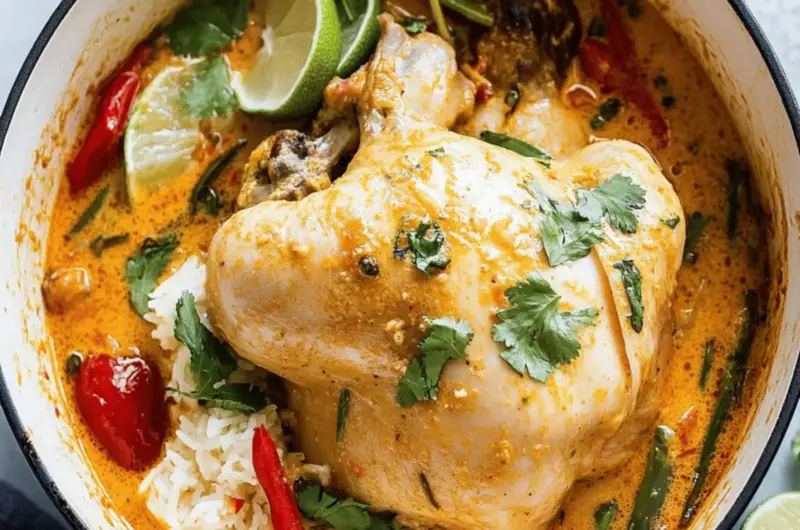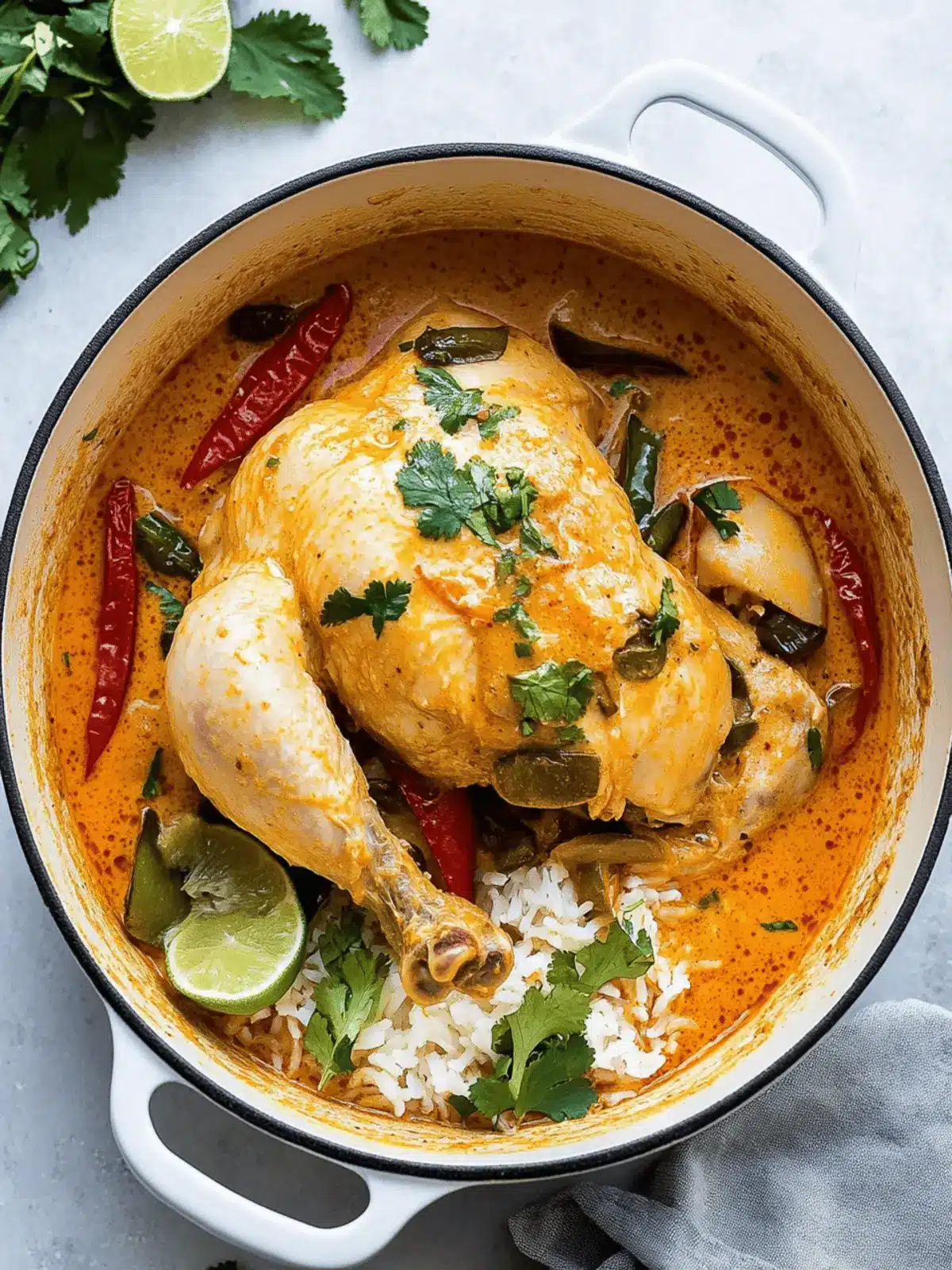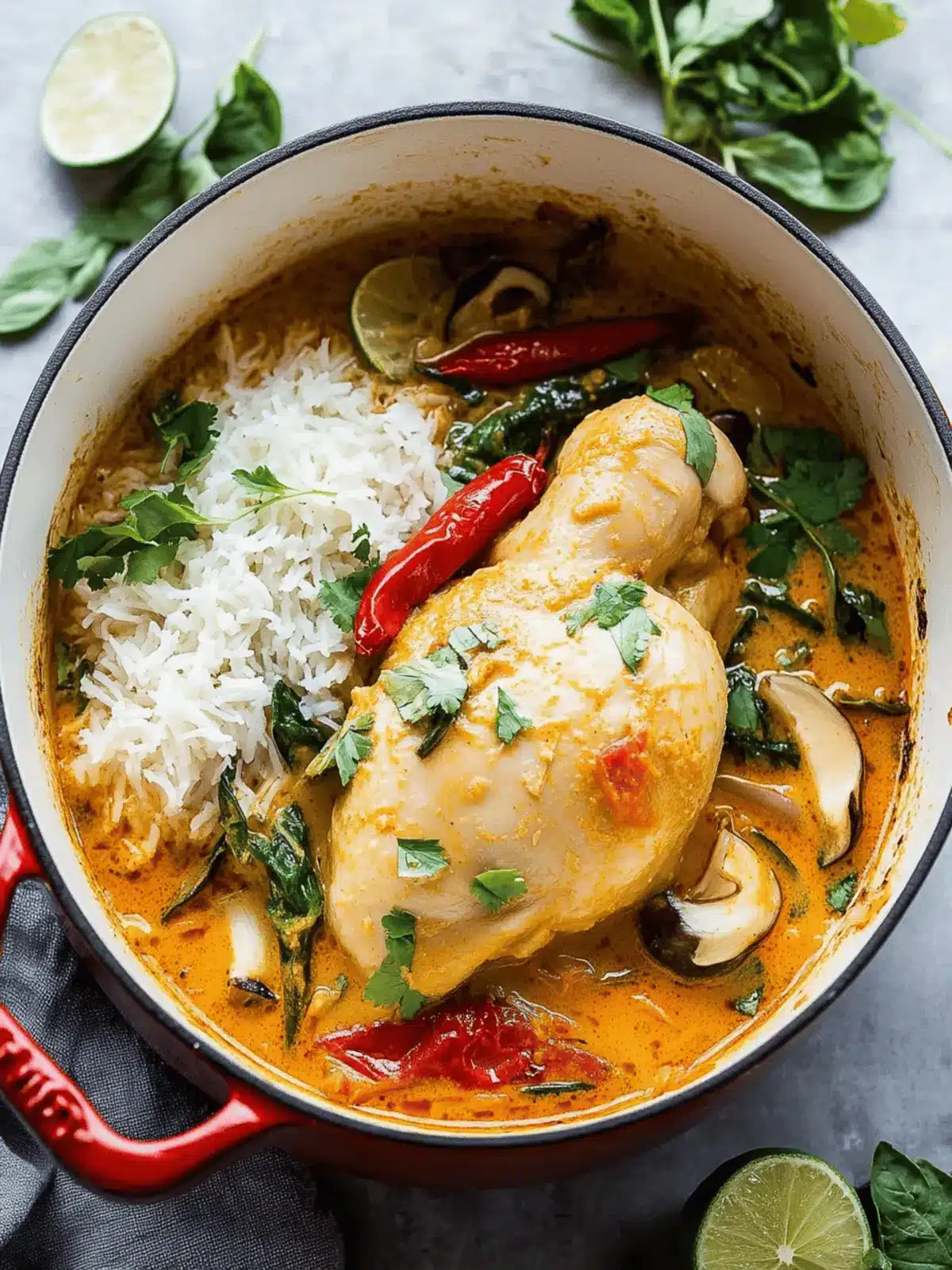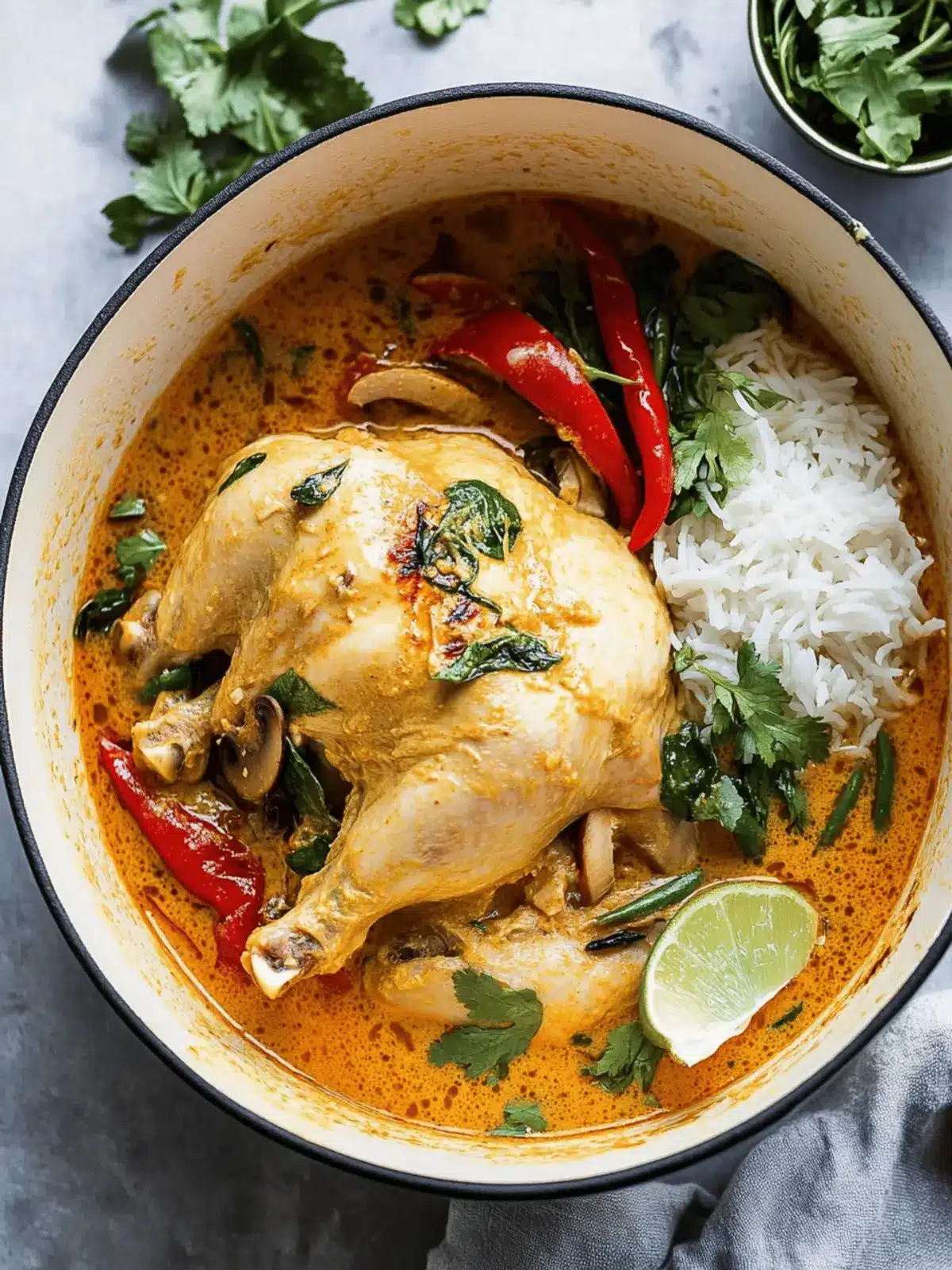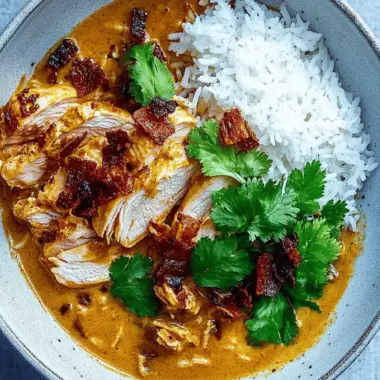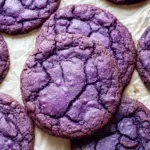There’s something absolutely enchanting about the first whiff of coconut curry simmering on the stove—it transports me right to the bustling streets of Thailand, where rich aromas beckon from every corner. As my family gathers around for dinner, anticipation builds, knowing that this Whole Coconut Curry Chicken will become the star of the evening. This one-pot dish is not just easy to prepare; it offers a beautiful balance of tender, juicy chicken infused with the comforting, creamy essence of coconut milk and fragrant curry spices.
Whether it’s a busy weeknight or a weekend family gathering, this recipe is designed to delight—turning what could be a mundane meal into an impressive showcase of flavor. The delightful blend of colors and textures makes this dish not just a meal but also a shared experience filled with warmth and love. Let’s roll up our sleeves and dive into this Thai-inspired culinary adventure that promises to satisfy your taste buds and shine on your dinner table!
Why Will You Love Whole Coconut Curry Chicken?
Simplicity, The beauty of this dish lies in its one-pot nature, making cleanup a breeze while you enjoy a robust meal with minimal effort.
Flavor Explosion, A harmonious blend of coconut milk and aromatic curry delivers an irresistible warmth and creaminess that will leave you craving more.
Family-Friendly, This is a dish everyone will enjoy—mild yet flavorful, perfect for even the pickiest eaters.
Versatile Veggies, Feel free to toss in your favorite seasonal vegetables, making it easy to customize for any palate.
Memorable Moments, This curry isn’t just food; it’s a heartwarming dish that brings family and friends together, paving the way for delicious conversations and cherished memories.
Whole Coconut Curry Chicken Ingredients
Unlock the deliciousness with these essential components!
For the Chicken
• Whole Chicken (3 to 4 pounds) – This is the star ingredient; using a well-farmed chicken enhances the flavor.
For the Broth
• Kosher Salt (2 teaspoons) – Essential for elevating the chicken’s natural flavors; sea salt works as a substitute.
• Extra-Virgin Olive Oil (3 tablespoons) – Used for searing the chicken and adds a rich depth to the broth; coconut oil can be a great alternative.
• Red Curry Paste (2 tablespoons) – The heart of the dish, giving it robust flavor and a hint of heat; look for Mae Ploy brand for the best experience.
• Yellow Onion (1 small, thinly sliced) – Introduces sweetness and aromatic depth; shallots make a mild substitute.
• Garlic (4 cloves, thinly sliced) – Infuses savory goodness throughout the dish; fresh garlic is highly recommended.
• Fresh Ginger (1 tablespoon, grated) – Adds a warm earthiness; in a pinch, you can use ground ginger.
• Coconut Milk (2 cans, shaken) – Vital for that creamy texture; opt for full-fat coconut milk for the best result.
For the Vegetables
• Red Bell Peppers (2, sliced) – Contributes vibrant color and sweetness; feel free to swap them for other colorful peppers.
• Lime Zest (1 teaspoon) – Provides a bright lift to the dish; lemon zest can be used if you’re in a pinch.
• Fresh Lime Juice (1 tablespoon) – Balances the richness of the curry; fresh juice is always superior to bottled versions.
For Serving
• Cooked Rice – The perfect base to soak up the delicious broth; you can use either white or brown rice.
• Fresh Cilantro & Basil (for garnish) – These herbs add a fresh note to the dish; optional, but highly recommended for extra flavor.
Dive into the wonderful world of Whole Coconut Curry Chicken with these carefully selected ingredients!
How to Make Whole Coconut Curry Chicken
-
Prepare the Chicken: Start by drying your whole chicken thoroughly with paper towels. Season the chicken generously with kosher salt, ensuring it’s well-coated for maximum flavor.
-
Sear the Chicken: In a large Dutch oven, heat the extra-virgin olive oil over medium-high heat. Carefully place the seasoned chicken in the pot and sear it for about 6-7 minutes on each side until golden brown.
-
Sauté Aromatics: Once the chicken is browned, remove it from the pot and set it aside. In the same pot, add the red curry paste, sliced onion, garlic, ginger, and 1 can of shaken coconut milk. Sauté until fragrant, about 3-4 minutes.
-
Simmer the Chicken: Return the seared chicken to the pot, cover it with a lid, and let it simmer on low heat for about 30 minutes, allowing the flavors to meld together and the chicken to cook through.
-
Add Vegetables: After 30 minutes, lift the lid and gently add the sliced red bell peppers, lime zest, the remaining can of coconut milk, and fresh lime juice. Cover and cook for another 10 minutes or until the chicken’s internal temperature reaches 165°F.
-
Rest and Serve: Once cooked, remove the chicken from the pot and let it rest for about 15 minutes before carving. Serve the tender chicken over a bed of rice, ladling the delicious curry broth over the top, and garnish with fresh cilantro and basil.
Optional: Serve with lime wedges on the side for an extra zing.
Exact quantities are listed in the recipe card below.
Make Ahead Options
This Whole Coconut Curry Chicken is perfect for meal prep enthusiasts! You can season and sear the whole chicken up to 24 hours in advance, storing it covered in the refrigerator to maintain freshness. Additionally, you can prepare the coconut curry broth (including the sautéed aromatics) and refrigerate it for up to 3 days; simply reheat before adding the seared chicken and sliced bell peppers when you’re ready to serve. To maintain quality, be sure to keep the chicken and broth separate until cooking. When ready to finish, simmer the chicken in the prepared broth for about 30 minutes until everything is heated through, ensuring a rich, flavorful dish with minimal effort.
Whole Coconut Curry Chicken Variations
Embrace your creativity and make this dish your own with these delightful twists!
-
Wings or Drumsticks: Swap the whole chicken for chicken pieces, like wings or drumsticks, for faster cooking and easy serving. These bites are perfect for family finger food fun.
-
Vegetable Boost: Toss in seasonal veggies like carrots, snap peas, or zucchini during the last 10 minutes of cooking. They’ll add color and a nutritious crunch, making every bite even more enjoyable!
-
Spicy Kick: Adjust the heat level by adding sliced fresh chilies or increasing the amount of red curry paste. Personalize the spice factor to suit your family’s taste!
-
Herbaceous Freshness: Experiment with fresh herbs such as mint or Thai basil instead of cilantro and basil. These ingredients can lend a unique twist and elevate the dish’s flavor profile beautifully.
-
Coconut Creaminess: For an even richer dish, stir in a dollop of creamy coconut yogurt just before serving. It adds a luxurious touch and balances the spices perfectly.
-
Savory Garlic Rice: Cook your rice with minced garlic and a little butter or coconut oil for an aromatic addition. This simple step enhances the flavor and aroma, turning your side into something special.
-
Fruit Infusion: Consider adding pineapple or mango chunks in the last few minutes of cooking for a delightful sweetness that contrasts beautifully with the savory curry.
-
Curry Alternatives: Change up the curry paste by trying green curry instead of red for a different flavor profile. This new variation will keep the family guessing and excited for dinner!
Feel free to mix and match these variations to create a version of Whole Coconut Curry Chicken that brings joy to your kitchen!
How to Store and Freeze Whole Coconut Curry Chicken
Fridge: Store the cooled Whole Coconut Curry Chicken in an airtight container for up to 4 days. Gently reheat on the stove over low heat, adding a splash of coconut milk to maintain creaminess.
Freezer: This dish can be frozen for up to 3 months. Let it cool completely before transferring to a freezer-safe container or bag. Thaw in the fridge overnight before reheating.
Reheating: When ready to enjoy again, heat on the stove or in the microwave until heated through. Stir occasionally to ensure even heating, adding more coconut milk if needed.
Ingredient Care: Always check the chicken’s internal temperature when reheating to confirm it is heated to at least 165°F before serving.
What to Serve with Whole Coconut Curry Chicken?
There’s nothing quite like a meal that brings together vibrant flavors and comforting textures to create a complete dining experience.
-
Fragrant Jasmine Rice: This classic pairing soaks up the delicious coconut curry broth, enhancing each bite with its light floral aroma.
-
Steamed Broccoli: The slight crunch and fresh taste of steamed broccoli adds a nutritious element while balancing the creaminess of the curry.
-
Crispy Spring Rolls: Filled with fresh herbs and veggies, these crispy delights provide a satisfying texture and a delightful contrast to the tender chicken.
-
Cucumber Salad: Refreshing and bright, a simple cucumber salad dressed in lime and rice vinegar cuts through the richness of the curry, awakening your taste buds.
-
Mango Chutney: The sweet and tangy notes of mango chutney beautifully complement the spices in the curry, offering a delicious accompaniment.
-
Chilled Coconut Water: This refreshing drink harmonizes with the coconut theme, hydrating while its subtle sweetness replenishes after the savory curry.
-
Lime Wedges: A splash of fresh lime juice just before serving elevates flavors, bringing brightness that enhances every bite.
-
Thai Iced Tea: The creamy and sweet notes of this traditional drink provide a perfect balance to the spiciness of the curry, making for an irresistible combination.
Expert Tips for Whole Coconut Curry Chicken
-
Coconut Milk Care: Ensure you shake the coconut milk cans well before opening to mix any separated cream for a smooth broth.
-
Perfectly Poached Chicken: Avoid dry chicken by checking the internal temperature with an instant-read thermometer to ensure it reaches 165°F effortlessly.
-
Finish with Flair: For a little extra thickness in the broth, consider stirring in a cornstarch slurry at the end to achieve that velvety consistency.
-
Flavor Balance: Don’t skip the lime juice! It brightens the dish and enhances the rich flavors of your Whole Coconut Curry Chicken spectacularly.
-
Resting Time: Allowing the chicken to rest after cooking lets the juices redistribute, ensuring each bite is deliciously moist and flavorful.
Whole Coconut Curry Chicken Recipe FAQs
How do I choose the best whole chicken for this recipe?
Absolutely! When selecting a whole chicken, I recommend looking for a well-farmed bird, ideally organic or free-range, weighing between 3 to 4 pounds for optimal cooking. The skin should be smooth and pale, with no dark spots or an off-smell. A fresh chicken will enhance the flavor of your Whole Coconut Curry Chicken significantly.
How should I store leftover Whole Coconut Curry Chicken?
After enjoying your delicious curry, allow any leftovers to cool to room temperature, then transfer them to an airtight container. They can be stored in the refrigerator for up to 4 days. When you’re ready to eat, gently reheat on the stove over low heat, adding a splash of coconut milk to restore its creamy texture.
Can I freeze Whole Coconut Curry Chicken?
Yes! To freeze, let the entire dish cool completely first. Then, transfer it to a freezer-safe container or heavy-duty freezer bag, ensuring you remove as much air as possible. Properly stored, the curry can last up to 3 months. For reheating, thaw it overnight in the fridge and warm it on the stove over medium-low heat until heated through, stirring occasionally to maintain the right consistency.
What if my chicken doesn’t cook through?
No worries! If you’re concerned about undercooking the chicken, check the internal temperature with an instant-read thermometer. The chicken should reach 165°F in the thickest part. If it isn’t done yet, simply cover and continue simmering, checking every 5 minutes until it reaches the right temperature. Remember, always let the chicken rest for about 15 minutes post-cooking for juicy results!
Is this recipe suitable for people with dietary restrictions?
Very much so! This Whole Coconut Curry Chicken is gluten-free, and it’s easy to make it dairy-free if you choose a suitable coconut milk. For those concerned about allergies, it’s best to check that the red curry paste doesn’t contain any fish or shellfish products, as brands can vary. Additionally, please ensure that any side dishes or rice served are also free from allergens.
How can I customize the heat level in this dish?
Feel free to adjust the spiciness to your preference! Begin with the base recipe using 2 tablespoons of red curry paste, then taste the broth before serving. If you like a little more heat, add an additional tablespoon of red curry paste or some sliced fresh chili peppers during the cooking process. Your family will love the flexibility of flavors you can create with this versatile dish!
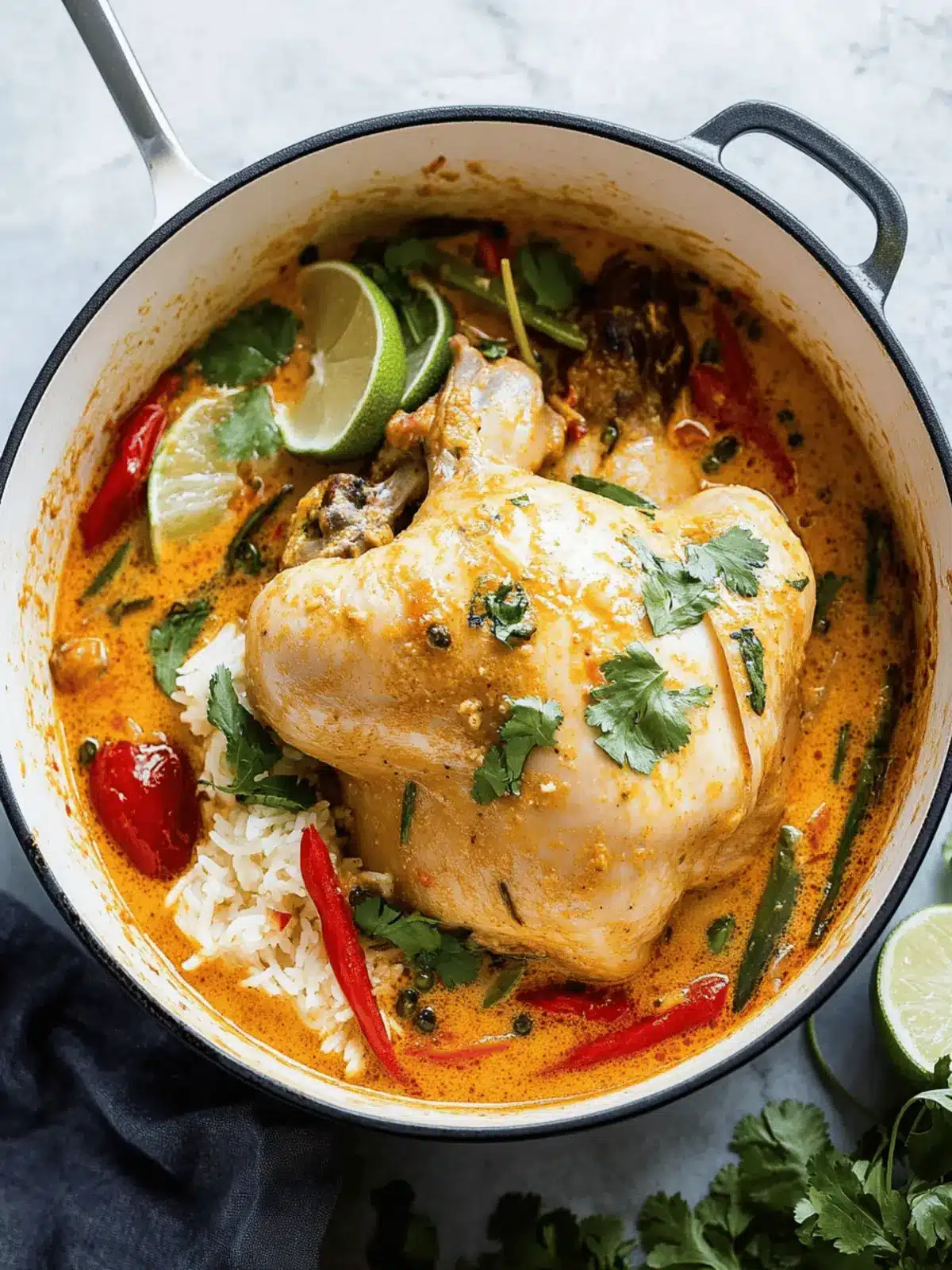
Whole Coconut Curry Chicken: Comfort in One Flavor-Packed Pot
Ingredients
Equipment
Method
- Prepare the Chicken: Start by drying your whole chicken thoroughly with paper towels. Season the chicken generously with kosher salt, ensuring it's well-coated for maximum flavor.
- Sear the Chicken: In a large Dutch oven, heat the extra-virgin olive oil over medium-high heat. Carefully place the seasoned chicken in the pot and sear it for about 6-7 minutes on each side until golden brown.
- Sauté Aromatics: Once the chicken is browned, remove it from the pot and set it aside. In the same pot, add the red curry paste, sliced onion, garlic, ginger, and 1 can of shaken coconut milk. Sauté until fragrant, about 3-4 minutes.
- Simmer the Chicken: Return the seared chicken to the pot, cover it with a lid, and let it simmer on low heat for about 30 minutes, allowing the flavors to meld together and the chicken to cook through.
- Add Vegetables: After 30 minutes, lift the lid and gently add the sliced red bell peppers, lime zest, the remaining can of coconut milk, and fresh lime juice. Cover and cook for another 10 minutes or until the chicken’s internal temperature reaches 165°F.
- Rest and Serve: Once cooked, remove the chicken from the pot and let it rest for about 15 minutes before carving. Serve the tender chicken over a bed of rice, ladling the delicious curry broth over the top, and garnish with fresh cilantro and basil.
- Optional: Serve with lime wedges on the side for an extra zing.

